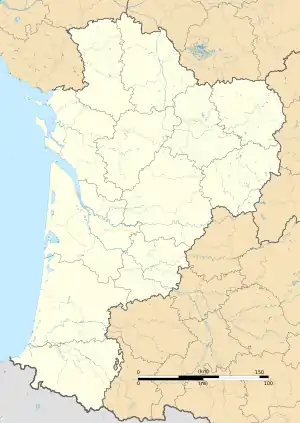Ostabat-Asme
Izura-Azme | |
|---|---|
 A general view of Ostabat-Asme | |
.svg.png.webp) Coat of arms | |
Location of Ostabat-Asme | |
 Ostabat-Asme  Ostabat-Asme | |
| Coordinates: 43°15′24″N 1°04′11″W / 43.2567°N 1.0697°W | |
| Country | France |
| Region | Nouvelle-Aquitaine |
| Department | Pyrénées-Atlantiques |
| Arrondissement | Bayonne |
| Canton | Pays de Bidache, Amikuze et Ostibarre |
| Intercommunality | CA Pays Basque |
| Government | |
| • Mayor (2020–2026) | Daniel Olçomendy[1] |
| Area 1 | 15.26 km2 (5.89 sq mi) |
| Population | 214 |
| • Density | 14/km2 (36/sq mi) |
| Time zone | UTC+01:00 (CET) |
| • Summer (DST) | UTC+02:00 (CEST) |
| INSEE/Postal code | 64437 /64120 |
| Elevation | 66–440 m (217–1,444 ft) (avg. 126 m or 413 ft) |
| 1 French Land Register data, which excludes lakes, ponds, glaciers > 1 km2 (0.386 sq mi or 247 acres) and river estuaries. | |
Ostabat-Asme (French pronunciation: [ɔstabat asm]; Basque: Izura-Azme), Hostavalem in the Middle Ages, is a commune in the Pyrénées-Atlantiques department, in south-western France.[3] It was the meeting point of 4 European ways to Santiago de Compostela, 3 of them joining together there, namely Paris - Tours - Poitiers - Dax, from Center - Europe linking to Limoges, from Genoa and Lyon through Moissac, the fourth one the Toulouse way, linking Central Italy with the Languedoc region, the Toulouse region and linking though the Béarn region, via Lescar-Oloron to Somport, Spain, and the Spanish Pyrénées.
The 3 linked Saint James ways proceed from there, through Larceveau-Arros-Cibits, Ainhice-Mongelos, Gamarthe, Lacarre and Iriberry towards Saint-Jean-le-Vieux, (43º09'57"N, 1º11'32" W), a.k.a. Donazaharre to Saint-Jean-Pied-de-Port, and to the Spanish Frontier, Roncesvalles, (42º59'23"N, 1º20'4"W) .
It is located in the former province of Lower Navarre. It gives its name to the region of Ostabarret.
See also
References
- ↑ "Répertoire national des élus: les maires". data.gouv.fr, Plateforme ouverte des données publiques françaises (in French). 2 December 2020.
- ↑ "Populations légales 2021". The National Institute of Statistics and Economic Studies. 28 December 2023.
- ↑ INSEE commune file
External links
- IZURA-AZME in the Bernardo Estornés Lasa - Auñamendi Encyclopedia (Euskomedia Fundazioa) (in Spanish)